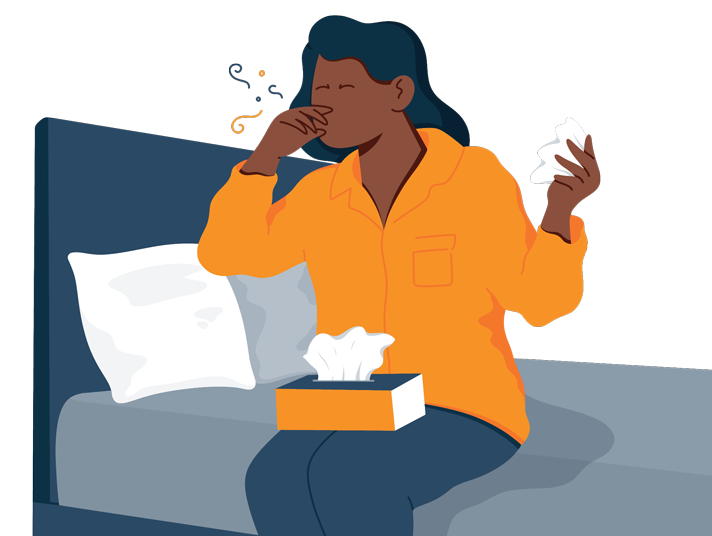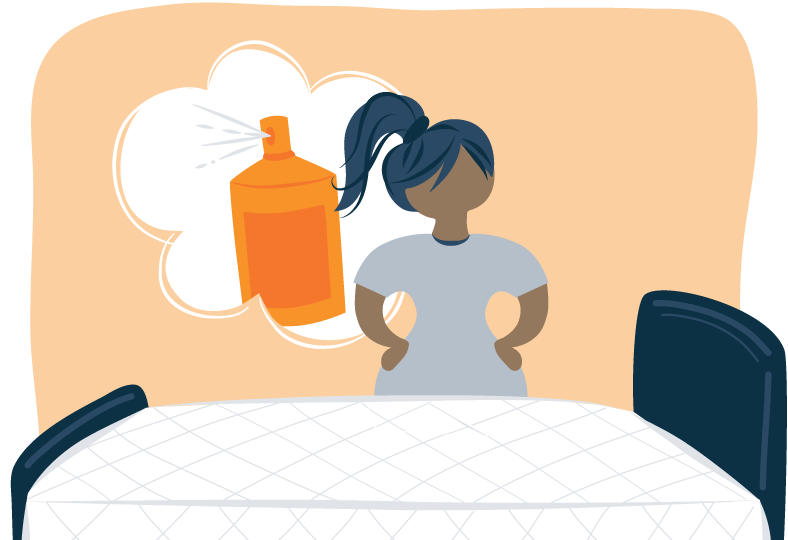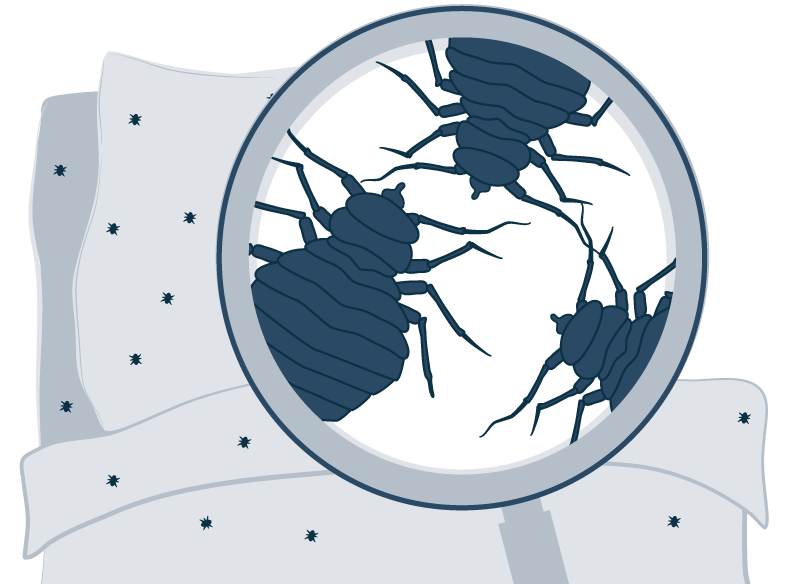Insects are probably the last thing you want joining you in bed, and dust mites are no exception. These tiny critters can infiltrate a bed, negatively affecting your health in the process.
These pests are tiny in size, but when they’re present – especially if you have allergies – they can have a big impact. Thankfully, with the right information, you can take preventive steps to keep them away.
This article will show you how to get rid of dust mites in your bed, including cleaning tips, the best products to use for averting them, and how to know if you have them.
Microscopic Danger
Dust mites are microscopic creatures that feed on the flakes of shed human skin, and they are the most common home allergen. These eight-legged bugs are in the Arachnida family, which means they’re related to spiders.
While they can live wherever humans are present, these irritants are commonly found in bedding – a typical place where humans shed dead skin.
These are not the same pests as bed bugs, though. Rather, mites cannot be seen with the naked eye, and you can’t feel them, nor do they bite you. That being said, they can still pose health risks.
Health Risks of Dust Mite Allergens
Mites may be common, but according to the American Lung Association, long-term exposure is harmful to those who are allergic or have asthma. Reactions to mites can range from mild to severe, and in those extreme cases, people might experience persistent sneezing, coughing, head pressure, or congestions. People with asthma could see an increased risk of flare-ups and severe attacks.
Investing in a hypoallergenic mattress can be particularly helpful for those who are allergic to dust mites. These beds are specifically made with anti-allergen and dust-preventing materials. Even for those who aren’t allergic, these critters are unhygienic, so you don’t want to keep them around.

How to Kill Dust Mites
Wash Your Bedding in Hot Water
When dealing with mites, you need to wash your bedding in extremely hot water. Any temperature over 122 degrees Fahrenheit should suffice. This is the minimum temperature required to kill off bugs.
Understandably, you can’t haul your entire mattress into the washing machine, so make sure you use a removable cover on your bed for washing. The cover, along with your sheets and pillowcases, should be washed thoroughly in hot water every week.
Baking Soda and Vacuum
For this method, you’ll mix a cup of baking soda with several drops of any essential oil. Then sprinkle the mix on the top of the mattress, and let it sit for 15 minutes. You’ll then vacuum up the baking soda, and repeat this process on the other side.
The goal is to collect the bugs with the baking soda. Be sure to use a vacuum with a HEPA filter, though. HEPA vacuums are designed to collect dirt without recirculating those allergens back into the room.
Use Homemade Dust Mite Spray
There are also sprays you can purchase to fight off these irritants. While these sprays are helpful, they alone won’t solve your pest problem, so be sure to still apply additional cleaning methods as well.
You may also consider other household cleaning products to keep the insect numbers under control. Lysol is great for killing the allergens, but note that it will still leave behind their feces and remains, though.
Sprinkle Diatomaceous Earth
While you want to rid your bed of allergens, you may prefer to use a safer alternative to sprays. Diatomaceous Earth is a non-poisonous powdered substance made from the fossilized remains of tiny organisms known as diatoms.
Diatomaceous Earth is used to kill insects and pests by absorbing their oils and fats from their exoskeletons, causing them to dry out and die. All you need to do is sprinkle the powder onto your bed, leave it on there for at least 30 minutes, and then vacuum it up.
Call Cleaning Professionals
In the event you try these methods and still have no luck, it may be time to call in the professionals and book an appointment to have your mattress cleaned. Before sending in reinforcements, though, you should verify with the cleaner what products they use, as they may contain harmful chemicals that could cause you additional irritation. The cleaner may be able to apply methods that do not use chemicals like steam cleaning or ultraviolet light, though the results may not last as long.
How to Prevent Dust Mites
Protect Your Mattress
Purchasing a mattress encasement could also help protect your bed against mites by creating a shield between you and the allergens.
Although it might be easy to assume mattress protectors and encasements are the same, there is a significant difference between them. A protector will safeguard the top of your bed, while an encasement covers the entire mattress. Both products will help, but an encasement should deliver more full protection.
Not only are mattress protectors good for these allergens, but they can also protect your sleep space from liquid spills and another unpopular pest: bed bugs.
Switch to Hypoallergenic Materials
Today’s market is full of high-quality hypoallergenic mattresses and bedding products specially designed to keep allergens away. For those who are constantly feeling the effects of these irritants, consider purchasing a hypoallergenic mattress.
Most latex mattresses and pillows are hypoallergenic, which means they are not susceptible to mites, along with mold and other harmful microbes. Although memory foam beds are highly popular, if dust mites are your prime concern, mattresses made with latex foam should provide additional airflow to keep your mattress cool and dry.
Since these insects prefer humid environments, this should help make your bed less hospitable for them.
View Our Guide: Top Rated Latex Pillows
Lower the Temperature
Just as hot temperatures can kill off allergens, so can the extreme cold. This technique should help if you have delicate bedding materials and products that cannot go through the washing machine like silk, lace, certain pillows, and stuffed toys.
Depending on your freezer’s size, you may need to go through several rounds of this for all your bedding items. Start by placing each product into a plastic bag. Then put them in your freezer and leave them there for at least 24 hours.
After the 24-hour period, take your bedding outside and shake everything out thoroughly so that you remove the remains.
Keep Pets Out of Your Bed
We may consider our pets a part of the family, but that doesn’t mean it’s a good idea to let them hang out in our bed. Like humans, dogs and cats attract dust mites, which means they could increase the likelihood of the allergens invading your sleep space.
Rather than let them sleep with you, invest in a good bed for your pets, so they can have their own comfy place to rest. Because cats and dogs can also be allergic to these irritants, don’t forget to regularly clean their bed too, and cover the bed in plastic if necessary.
Learn More: Pros and Cons of Sleeping With Pets
Frequently Asked Questions
How do I know if I have them in my bed?
Mites aren’t visible without a microscope, so instead, you have to analyze your symptoms. People who are allergic to them may experience sneezing, coughing, wheezing, watery eyes, difficulty breathing, nasal congestion, and itching. When you wake up with these symptoms and do not have a cold, you likely have this allergen in your bed.
Does chlorine bleach kill dust mites?
While hot water is ideal for killing pests, you may prefer not to use it on your bedding. In this case, consider adding chlorine bleach to your wash load. A 2010 study reported that the cleaning substance was able to successfully kill mites, even when they used water below 122 Fahrenheit.
Resources:
- Dust Mite Allergy – mayoclinic.org
Jill Zwarensteyn
Editor
About Author
Jill Zwarensteyn is the Editor for Sleep Advisor and a Certified Sleep Science Coach. She is enthusiastic about providing helpful and engaging information on all things sleep and wellness.
Combination Sleeper


